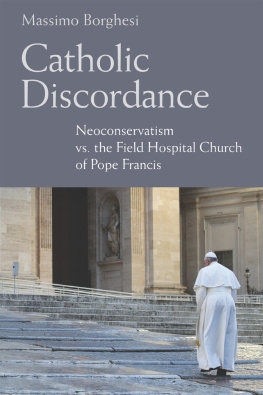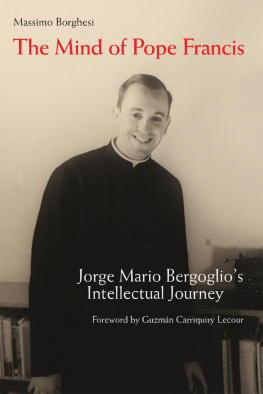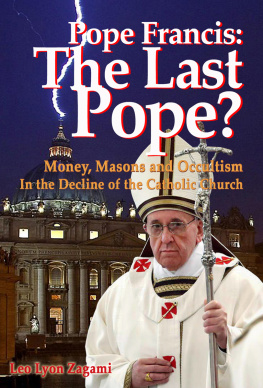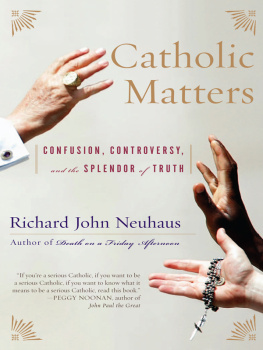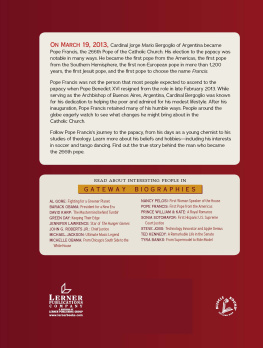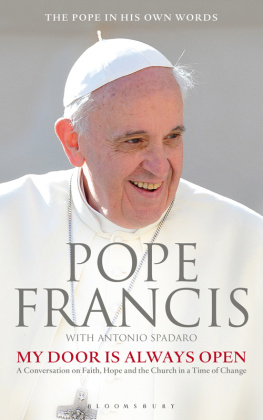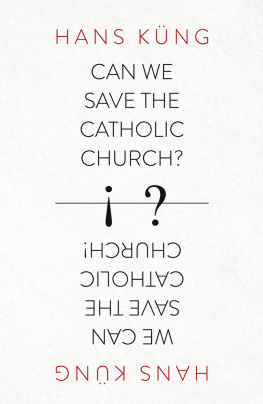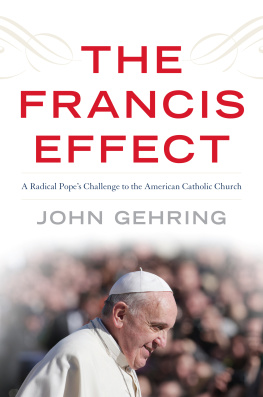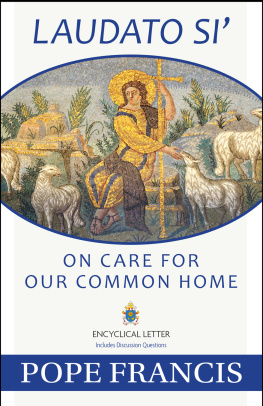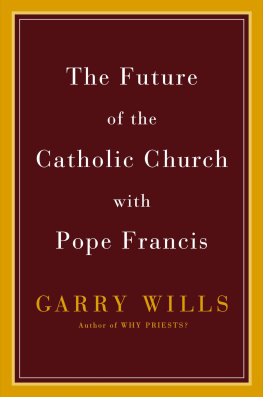Expanding his earlier defense of Pope Francis from critics who consider the pope a theological and intellectual lightweight, Massimo Borghesi leads us through a very readable analysis of the neoconservative, largely American, detractors of the magisterium of Francis. It is not too surprising that the first Latin American pope, who prefers the peripheries to the centers of power, would generate resistance from the defenders of capitalism and whose vision of the church as a field hospital for sinners would be rejected by traditionalists who overly identify the faith with its moral teachings. Borghesi describes how Bergoglios insistence on discernment charts an ecclesial course which rejects both extremes of fundamentalism and relativism.
Bishop John Stowe, OFM Conv, Diocese of Lexington
With this splendidly researched volume, Borghesi further establishes his place in the first rank of interpreters of the Francis papacy and the challenges it faces. Building upon his previous scholarship on the thought of Pope Francis, Borghesi here analyzes the fault lines on display in the stalwart resistance by Catholic neoconservatives and traditionalist culture warriors to the ecclesiological commitments of the first Jesuit pope. Profound insights into the tensions within twenty-first-century Catholicism jump off every page. Highly recommended for anyone seeking a deeper understanding of the forces behind contemporary struggles for the renewal of church life.
Thomas Massaro, SJ, Professor of Moral Theology at Fordham University
This is an essential book as Borghesi does not write a history of the pontificate of Pope Francis, but a genealogy of a tradition: his most influential intellectual opponents on the Rome-Washington axis. Borghesi draws a picture of the ideological, America first, neoconservative, and turbo-capitalist deviations in the Catholic Church in the USA since the 1980s. He thus offers an indispensable contribution to understanding a broader season in the history of Catholicism that precedes Franciss pontificate and probably will continue for a long time.
Massimo Faggioli, Professor of Historical Theology, Villanova University
If you have ever wondered why opposition to Pope Francis, especially from the United States, is so intense, look no furtherbut bring a spare highlighter. Laying bare the ideological corruption and political ambition of the theocons, Massimo Borghesi has given us a masterly account of Franciss discernment of the churchs mission to the contemporary world, and the resentment of those it dethrones. Thrilling in its breadth and depth, beautifully translated, and crammed with insights, Catholic Discordance is the definitive analysis of the choices and tensions the church faces in a post-Christendom world.
Austen Ivereigh, author of Wounded Shepherd and co-author of Pope Franciss Let Us Dream
Originally published as Francesco: La Chiesa tra ideologia teocon eospedale da campo
2021
Editoriale Jaca Book Srl
All rights reserved
Milan
Worldwide permissions secured by author for sources quoted at length.
2021 by Order of Saint Benedict, Collegeville, Minnesota. All rights reserved. No part of this book may be used or reproduced in any manner whatsoever, except brief quotations in reviews, without written permission of Liturgical Press, Saint Johns Abbey, PO Box 7500, Collegeville, MN 56321-7500. Printed in the United States of America.
Library of Congress Cataloging-in-Publication Data
Names: Borghesi, Massimo, 1951 author. | Hudock, Barry, translator.
Title: Catholic discordance : neoconservatism vs. the field hospital church of Pope Francis / Massimo Borghesi ; translated by Barry Hudock.
Other titles: Francesco. English
Description: Collegeville, Minnesota : Liturgical Press Academic, [2021] | Includes index. | Summary: An analysis of the origins of todays Catholic neoconservative movement and its clash with the church that Francis understands as a field hospital for a fragmented world Provided by publisher.
Identifiers: LCCN 2021027533 (print) | LCCN 2021027534 (ebook) | ISBN 9780814667354 (hardcover) | ISBN 9780814667361 (epub) | ISBN 9780814667361 (pdf)
Subjects: LCSH: Francis, Pope, 1936- | Church. | Catholic ChurchHistory21st century.
Classification: LCC BX1378.7 .B66713 2021 (print) | LCC BX1378.7 (ebook) | DDC 282dc23
LC record available at https://lccn.loc.gov/2021027533
LC ebook record available at https://lccn.loc.gov/2021027534
To the small group of friends
with whom Ive shared some great intellectual sparring in recent years:
Lucio Brunelli, Rocco Buttiglione, Guzmn Carriquiry Lecour,
Emilce Cuda, Rodrigo Guerra Lpez, Austen Ivereigh,
Alver Metalli, Andrea Monda, Andrea Tornielli
Contents
Introduction
Beyond the Theological-Political Model: Pope Franciss Mobile Church
On the evening of Friday, March 27, 2020, as the COVID-19 pandemic claimed dramatically higher numbers of victims with each passing day, a scene unfolded in Rome that millions of viewers around the world who watched via live broadcast will not soon forget: a pope standing by himself before an empty and rain-beaten St. Peters Square, praying to God for all humanity.
The silence that surrounded him was surreal. Behind the pope stood the icon of Mary as the Salus Populi Romanithat is, the health, or salvation, of the Roman peopleordinarily housed in the great Basilica of St. Mary Major, and the wooden crucifix of San Marcello, which, according to tradition, saved the Romans during the plague of the sixteenth century. The pope implored the Lord not to abandon the world to fear. Addressing the world, he began:
When evening had come (Mk 4:35). The Gospel passage we have just heard begins like this. For weeks now it has been evening. Thick darkness has gathered over our squares, our streets and our cities; it has taken over our lives, filling everything with a deafening silence and a distressing void, that stops everything as it passes by; we feel it in the air, we notice in peoples gestures, their glances give them away. We find ourselves afraid and lost. Like the disciples in the Gospel we were caught off guard by an unexpected, turbulent storm. We have realized that we are on the same boat, all of us fragile and disoriented, but at the same time important and needed, all of us called to row together, each of us in need of comforting
Images of the lonely pope standing in a deserted St. Peters Square circulated immediately around the world. More than any possible description, they made clear the tragedy of humanity bent low by the epidemic. As the Italian professor of political science Alessandro Campi wrote,
Images of Pope Francis celebrating Mass alone, in a dark, desolate, and rain-battered St. Peters Square, were broadcast everywhere. To some it seemed like the withdrawal of faith and organized religion from the worlda fact so unprecedented and grandiose as to exacerbate the universal bewilderment that held sway, and not only of believers. But in those images, which are indeed disconcerting, many have instead seen a message of hope, a powerful signal. In a world deeply touched by secularization, rendered almost spiritually sterile by it, and incapable of guaranteeing a peaceful pluralism of beliefs marked by a secular and enlightened tolerance, the solitary figure of the pontiff praying for the well-being of all has suggested more encouraging thoughts: on the one hand, the redemption of religious culture over secular culture (which, in the face of the ultimate drama of death, fails to offer any consolation); on the other, an invitation to community and sharing, addressed to the world and widely accepted by it, beyond the diversity of faiths and beliefs.

